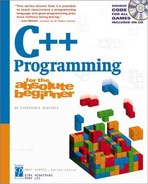Chapter 6. Creating a Windows Program: The Visual Critter
The first programs in this book are much like the programs in the early high-level languages, such as COBOL and FORTRAN. These programs work primarily on the command line and begin with straight-line logic. As you have progressed in your own programming, you have used more complex logical structures, such as loops and branching statements, and you have played around with more complex data structures, such as variables. The history of programming follows the same progression. In the past two chapters, you looked at object-oriented programming, which represents the current thinking in program design, but your programs still do not seem very modern because they are written on the ugly and unfriendly console. In the next few chapters, you will look at how C# is used in Windows programming. The programs you will write feature the capabilities of the Windows operating system, with all the graphical features you have come to expect from such a system.
Now you will explore how to build a program with a Windows interface. In this chapter you will
Learn the basic concepts of a graphical user interface (GUI).
Use the IDE to build an interface.
Navigate the System.Drawing and System.Windows namespaces.
Add the most common GUI elements (text boxes, labels, images, scroll bars, and multiple selection elements) to your forms.
Write event-handling code.
Use event-driven programming.
